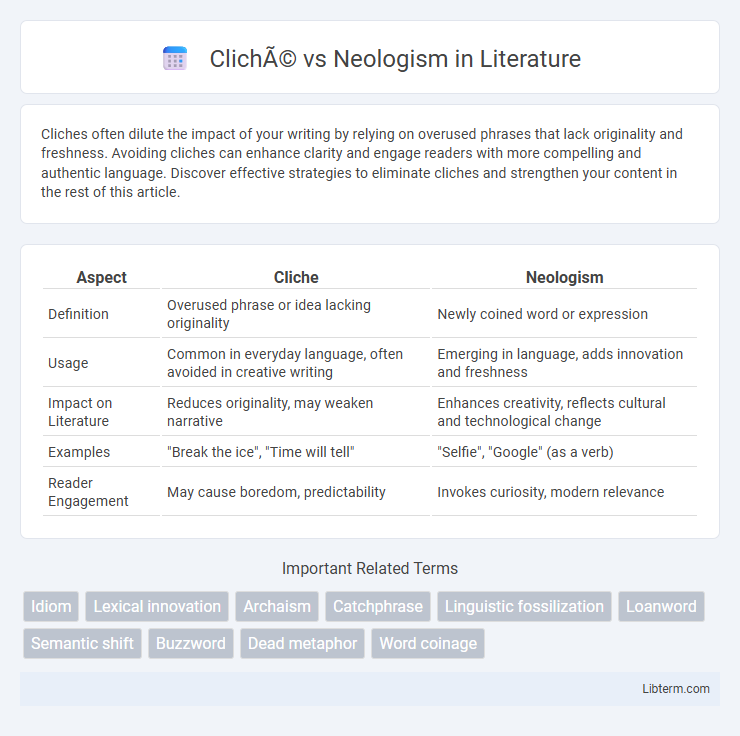Cliches often dilute the impact of your writing by relying on overused phrases that lack originality and freshness. Avoiding cliches can enhance clarity and engage readers with more compelling and authentic language. Discover effective strategies to eliminate cliches and strengthen your content in the rest of this article.
Table of Comparison
| Aspect | Cliche | Neologism |
|---|---|---|
| Definition | Overused phrase or idea lacking originality | Newly coined word or expression |
| Usage | Common in everyday language, often avoided in creative writing | Emerging in language, adds innovation and freshness |
| Impact on Literature | Reduces originality, may weaken narrative | Enhances creativity, reflects cultural and technological change |
| Examples | "Break the ice", "Time will tell" | "Selfie", "Google" (as a verb) |
| Reader Engagement | May cause boredom, predictability | Invokes curiosity, modern relevance |
Understanding Clichés: Definition and Examples
Cliches are overused phrases or expressions that have lost their original impact due to excessive use, such as "break the ice" or "once in a blue moon." These phrases often become predictable and fail to engage readers or listeners effectively. Recognizing cliches helps in refining language to avoid dullness and promote originality in communication.
The Evolution of Neologisms in Modern Language
Neologisms constantly emerge as dynamic reflections of cultural, technological, and social changes, enriching modern language with innovative expressions. Unlike cliches, which are overused and predictable, neologisms capture fresh ideas and evolving concepts, often driven by digital communication and globalization. This continuous linguistic evolution showcases human creativity and adaptability in communication.
Historical Origins: Where Clichés and Neologisms Come From
Cliches originate from frequently repeated phrases rooted in historical literature, speeches, and common cultural experiences, gradually losing their original impact due to overuse. Neologisms emerge from technological advancements, cultural shifts, and contemporary social phenomena, reflecting evolving language needs and innovations. The historical origins of cliches and neologisms highlight the dynamic nature of language shaped by societal changes and communicative trends.
Cultural Impact: How Clichés Shape Communication
Cliches influence cultural communication by providing familiar expressions that facilitate quick understanding and shared meaning across diverse groups. Their repeated usage reinforces social norms and collective values, embedding common experiences within everyday language. Over time, cliches can both unite and limit creativity, as they become predictable patterns that frame cultural narratives and communication styles.
Creativity Unleashed: The Role of Neologisms in Expression
Neologisms serve as powerful tools in creativity, offering fresh vocabulary that reshapes how ideas are communicated and perceived, breaking free from the limitations imposed by cliches. Unlike cliches, which often convey stale or predictable meanings, neologisms introduce innovation by reflecting contemporary culture, technological advancements, and evolving social dynamics. Embracing neologisms in language enriches expression, inspires original thought, and fosters dynamic interaction in literature, marketing, and everyday communication.
Common Pitfalls: Overusing Clichés in Writing
Overusing cliches in writing leads to predictable and uninspired content, diminishing the originality and impact of the message. Writers often fall into the trap of relying on familiar phrases instead of crafting unique expressions that engage readers. Avoiding cliches enhances clarity and strengthens the voice, making the text more compelling and memorable.
Embracing Innovation: Benefits of Using Neologisms
Neologisms drive innovation by introducing fresh terms that capture emerging ideas and technologies, enhancing communication clarity in rapidly evolving fields. Embracing these new words fosters creativity, improves engagement, and differentiates brands or content in competitive markets. Unlike cliches, which often feel stale and overused, neologisms provide dynamic, precise language that resonates with modern audiences and supports forward-thinking discourse.
Reception and Acceptance: Public Response to New Words
Neologisms often face initial resistance or skepticism from the public, as unfamiliar words can disrupt established language patterns and communication norms. Over time, widespread media usage, social endorsement, and practicality contribute to the gradual acceptance of neologisms into everyday vocabulary. In contrast, cliches are generally accepted immediately due to their familiarity, but they risk becoming stale or meaningless through overuse, affecting their reception negatively.
Striking a Balance: Combining Familiarity and Novelty
Striking a balance between cliche and neologism enhances communication by blending familiarity with innovation, ensuring messages resonate while capturing attention. Utilizing cliches offers immediate recognition and comfort, whereas neologisms inject freshness and originality, appealing to evolving cultural contexts. Effective language strategies integrate both elements to maintain clarity and engagement, improving audience connection and retention.
Cliché vs Neologism: Finding Your Unique Voice in Writing
Cliches are overused phrases that dilute originality and weaken the impact of your writing, while neologisms introduce fresh, inventive language that captures attention and conveys unique perspectives. Embracing neologisms allows writers to express ideas distinctly and develop a personal voice, setting their work apart in a saturated literary landscape. Striking a balance between familiar expressions and innovative terms enhances clarity and creativity, ultimately strengthening narrative authenticity.
Cliché Infographic

 libterm.com
libterm.com